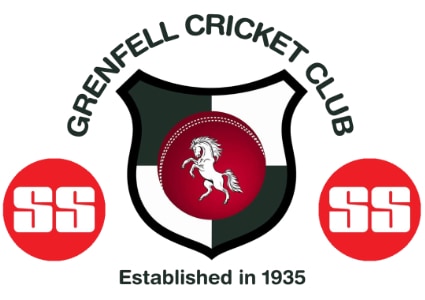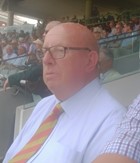
David Charles Sitch
GrenfellCC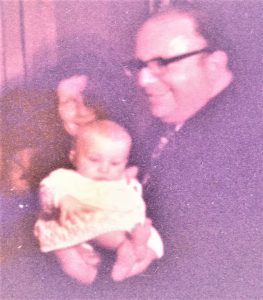
1977. Godfather Dave with Simon. Teresa in background
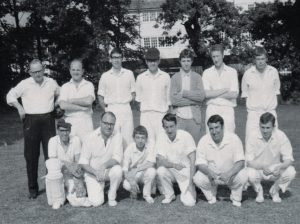
A 1969 XI. Back row: Harold Tozer, Len Johnson, Greg Stevens, Clyde Cartwright, Ian Curle, Ken Angelo, Alan Wild.
Front Row: John Strelley, Dave Sitch, Phil Blake, Stan Chisnell, Alan Coupland, Keith Finch
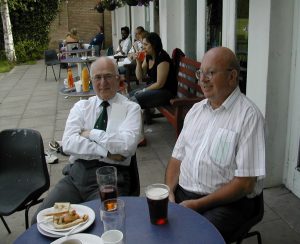
2005. Dave with Len Johnson at the Clubs 70th Anniversary celebration fixture
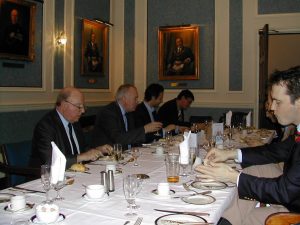
Dave at the 2005 Gentlemen’s Supper. On his immediate left is Keith Finch. Gary Willson and Keith Secrett are further to his left. Nick Power is opposite
This year, 2018, sees the eightieth birthday of one of my oldest, closest and dearest friends, Dave Sitch and one of Grenfell’s most popular and respected cricketers. Time, I think, to reflect on his career.
My friendship with Dave goes way beyond that of cricketing team mate. Over the years he became entwined with my family life as godfather to my son, Simon and with my one-time business venture when his own accountancy business practice was appointed our auditor. In the last fifty or so years, it would be impossible to say how many days we have spent together at County or Test cricket matches, a couple of hundred maybe. Other than that, we just hang out in pubs.
The first thing to clear up is why he is popularly and universally known as “Joe”. Unfortunately I cannot, he picked up the nickname at school for no apparent reason and it has just stuck. The school in question is Dartford Grammar school; Dave was born and raised in Bexley , the only child of Charles and Connie.
He started playing cricket with Lamorbey C C juniors progressing to the senior side from the age of sixteen. Short in stature, he is about 5’ 7”, but with powerful upper body strength he was a right-arm fast bowler delivering from a short but rapid run-up. Unusually, speaking generally, he preferred bowling in plimsolls rather than boots. He was also an athletic fielder. Blessed with speed and a big throw he was an outstanding out-fielder. He continued to play for Lamorbey until 1965 but they reduced their fixtures to Sunday only consequently Dave looked for a Saturday team and for 1959 and 1960 seasons played additionally for Burroughs Wellcome.
His career with Grenfell began in 1961 after being introduced to the club by Vic Mason one of his Lamorbey team mates who had played Saturdays for Grenfell since 1959. Not quite 23 years old Dave was the youngest player in an aging team where apart from Alan Coupland and Alan Cartwright the others were all in their thirties, even forties. He made an immediate impact; in 15 matches he took 29 wickets from 147 overs, the third most used bowler and second in the averages with his first five wicket analysis, 5-49 against Greenheath.
Two years later (1963) he was the main strike bowler. Nobody bowled more than his 199 overs which yielded 34 wickets (av. 14.47). Always a decent tail end batsman he emerged that year as a seriously useful lower middle order batsman. Not a big hitter but an orthodox batsman with a classic stance and a model cover drive it was his best ever seasons total; 154 runs at a noteworthy average of 12.83. He also achieved his career best highest score of 33 versus Met Police on 25 August. It was a remarkable match in that Grenfell, batting second, were three wickets down without a run on the board and the first thirty-one runs scored were all attributed to Ron Stevens. Ron went on to make 53 and only Dave, batting at number seven made any other significant contribution against a hostile bowling attack.
I was beginning to play a few matches in 1963 and it was batting with Dave that I have good reason to recall. Our arch rivals at that time were Dagenham Dock and we were playing them in an all-day fixture. On a sunny mid-June day we had batted really well to be about 130 for 2 by lunch. For lunch they took us to their nearby works canteen for a two-course meal washed down with copious amounts of beer. As a 16-year-old schoolboy my indulgence was carefully monitored but not so my team-mates – and it told. On resumption of play, in about five overs, we descended from 130 for 2 to 140 for 9 when I walked out to join Dave. Sensing my nervousness – I had only had two previous innings – Dave came to greet me with “Will you let me call all the runs?”
“ Yes, please”, immediately relieving me of one of my fears.
“Ted”, I told him (Ted Gorham was our captain), “says not to come back until we’ve made it at least 150 runs”. I had no confidence that I could stay around that long but Dave sprinted a quick run to get me off the mark when I nudged a ball past third slip. Thereafter Dave took control, shepherding most of the strike but whenever I was left to face he would come down the wicket with words of encouragement. At 149 I found the sureness to sweep at a slightly leg-side delivery and watched it go through mid-wicket for 4. I’d brought up the 150 and scored my first boundary! Dave hit a couple more boundaries and Ted was delighted to be able to make a face-saving declaration.
It was my first experience of Dave’s unselfish attitude towards team mates’ performance.
The following season brought Dave’s most wickets in a season. He was the leading bowler his 43 wickets coming in 185.2 overs at an average of 10.76 with three five wicket analyses. The best of these remains his best ever; 8 – 28 against Old Colfeians on 9 August. Opening the bowling from the bottom end of the J&P ground, our home pitch, a bouncer struck the opposition’s opening batsman on the head causing a severe cut behind his ear as he turned away. With their top batsman led off to hospital the remaining batsmen showed no heart for an aggressive spell of bowling and Dave ended with 8 – 28 (and a retired hurt). That they lost nerve was not surprising as we also showed no desire to pick up a ball covered in blood. The week before Dave had taken 5 – 44 against strong opponents, Peek Frean. His 6 – 25 against Eltham Oddfellows on 4 July had been his previous best.
The stock bowling of medium pace bowlers Alan Coupland and Taffy Holman had overtaken Dave as the most used bowlers and leading wicket takers and although Dave was the third used bowler in 1965 with 131 overs he took only 14 wickets with conditions favouring swing and spin bowling.
With his objective observations and positive outlook he was always a captaincy candidate so it was no surprise when he was elected vice-captain for both 1966 and 1967 seasons. As it happens skipper Stan Chisnell’s domestic circumstances gave Dave an unusually large number of opportunities to lead. A good tactician, quick to recognise his teammates’ skills he readily utilised their abilities but modestly overlooked his own. Consequently in 1967 he bowled only 17 overs. Under Dave, a friendly, jovial, hospitable character invariably at the hub of social events, team spirit was predictably high. Win or lose it was common practice to socialise with opponents providing drinks from a large jug. With this in mind, at the Club’s 1966 annual dinner and dance, in a mock award, Dave was ceremoniously presented with the Joe Sitch Trophy. An eight-pint enamel coated jug painted with the club’s insignia and bearing his name. This jug accompanied us to every game for the best part of the next twenty years.
It is worth recording that 1967 was arguably our most successful season with only three games lost. Dave captained eight of the matches and was unbeaten. He was never interested, though, in taking on the captaincy permanently and consistently refused to accept nomination to do so. He was however a popular ad hoc choice whenever the captain or vice- captain were unavailable. Inevitably it meant he would be handling a weakened team and on at least three occasions I recall him apologising to the opposition, “Sorry but we are not very strong today” anticipating their disappointment. However, always a bold captain, on winning the toss he elected to bat. On each of these occasions his hotchpotch side responded and we posted impressive scores and went on to win.
1969 was an unusual season in that five bowlers, Ken Angelo, Keith Finch, Ian Curle, Pete Cocklin and Alan Coupland took 269 wickets between them and only six bowlers made the averages. Dave was among many fine bowlers that were unused and barely made the “also bowled”. 1970 was not much better, he was again underused bowling only 35 overs and taking only 3 wickets. He came back in favour under Alan Coupland’s captaincy with 10 wickets (av.12.10) in 1971. That same summer he shared in a 7th wicket stand of 87 against Bowrings on 5 June with Ken Angelo. Ken made 92 and Dave 21. It was a club record which stood for 39 years. His godson, Simon Stevens figuring prominently in the new record in 2010.
A big change came in 1972. I captained the side against City of London Poly and having employed the off spin of Stan Chisnell who met with some success felt another spinner from the other end would be good but we didn’t have one. I seen Dave bowl spin in the nets and in warm up and asked him if he would give it go. Perhaps he had already bowled spin and I had forgotten. Anyway, he did give it go and
took three wickets. What makes Dave such a good bowler is that he bowls an impeccable length and line, whatever he bowls, and he makes it look so natural. The fact is, though, that it is not a gift but the result of dedicated practise. Dave was a regular at winter nets. Throughout the nineteen-sixties at Eltham Baths and the White Hart and when in the nineteen-seventies they moved to Messeter Place, at the other end of Eltham, the Rising Sun.
Anyhow, from then on he became the Club’s first choice spin option finishing that season with 9 wickets in his new role and second in the averages. 9 wickets (av 17.88) in 1973, 11 (av.15.27) in 1974 saw him finishing in the top half of the bowling averages. In 1975, in which year Ken Angelo took 101 wickets, his 17 wickets (av.11.41) placed him second in the averages and brought his first five wicket analysis as a spinner, 5-24 against Old Colfeians in the opening match of the season. The drought summer of 1976 was a batsmen’s summer, not good for any bowlers but especially poor for the spinners, the hard dry wickets too firm to offer turn. ”Like bowling on glass” he once said. Nevertheless his 13 wickets at a very respectable average of 12.69 saw him third placed amongst the regular bowlers, his best that year 5-38 versus strong opponents, Elmstead.
He played only two matches in 1977 but bowled two respectable spells taking 6-30 in 15 overs. In 1978 and 1979 he was averaging 5 to 6 overs a game and 10 wickets (av. 14.20) and 14 wickets (av. 14.14) respectively again placed him in the top half. In 1980 he was well used, bowling 92 overs in 13 games and taking 19 wickets (av. 13.36), his best season’s total since 1964. It was one game in this season that he gave me a bit of advice that stayed with me for the rest of my playing career. It was a home match against Bexley and I had been brought on as the second spinner after Dave had taken a couple of early wickets. To my delight the ball was taking big turn and I too took a wicket. Dave continued to trouble the batsman and took a couple more wickets but I was starting to leak runs. I queried with Dave why they were getting after me and not him. “You’re turning every ball you bowl and they are reading it. I don’t spin every ball.” From then on neither did I. He finished with 5-30 that day.
Similarly, in 1981 he was the fifth most used bowler with 89 overs in 13 games but this time with only 12 wickets. It happens sometimes. 1982 sees my second spell as captain and I use Dave as first change bowler more often than not; in 17 games and 113 overs he takes 27 wickets at an average of 15.81. Only Alan Coupland and Keith Finch take more (and Keith only one more) as he finishes third in the averages. It is his third best seasons total at the age of forty-four.
6-48 against AEI (Gravesend) in 1983 was his best return as a spin bowler as he takes 15 wickets for the season from 72 overs in 11 games. John Heinson his captain in 1984 continues the ploy of using Dave as a first change bowler and he takes 17 wickets from 81 overs in 13 games. They are his last. He plays only a handful of games in the next season but we have joined the League and after just one game in 1986 he decides that at 48 years old he is too old for such competition.
It was a fun filled illustrious career throughout which he was held in high esteem by his fellow players but it was not the end of his association with the Club. When he stepped down from the vice captaincy in 1968 it had been to take on the office of Treasurer a position he held through to 1988 retiring from it in 1989. Exemplary in his devotion and commitment to the club it was not just as a player that he is well regarded.
The role of treasurer was one for which he was eminently suited having qualified as a Chartered Accountant in 1961 through the arduous and protracted route from articled clerk. The practice for whom he started, Sunderland, Mountstephen & Co went through a merger with national accountants, Cork Gully & Co, insolvency specialists. Uncomfortable and unhappy in such a large corporation Dave left in the nineteen-seventies to become a partner with an old acquaintance Ken Jeffries in K.A.Jeffries & Co based in East Dulwich. He remained there for the rest of his working life, partially retiring at age 65 but continuing for another ten years before finally calling it a day.
Dave was also a good footballer. Fast, direct, able to play on either wing but mostly outside-right and was both accurate and powerful in his use of the ball with either foot. In short, he was an ideal winger. From 1953 to 1956 he played Saturdays for Heathside Sports FC in the Dartford & District Minor League and as an adult in the Dartford & District premier or division 1 for Dartford Heath FC from 1956 to 1966. On Sundays he played for Lamorbey FC in the Kent Suburban League from 1955 to 1966. Team mates included fellow Lamorbey cricketers Mick Way and Hector Mullens. Mick and Hector were close friends socially as well as sportingly and Dave introduced them both to Grenfell on a permanent basis when Lamorbey CC folded in 1972.
By 1964 I and my friends were working in London. One, John Garner, was based in Gracechurch Street and I would meet him some lunchtimes at The Falstaff pub in Eastcheap which coincidentally was next door to Dave’s then office. I didn’t arrange to meet up with Dave on these occasions but inevitably we did. My friends and I. also frequently bumped into Dave at Charing Cross station after a Friday night in London where we were all looking to catch our last train home. It was my good fortune that my destination, Hither Green, was on the same route as Dave’s, Albany Park. Conversation kept us awake for my part of the journey but Dave, sadly, quite often ended up at the end of the line, Dartford. It was in these talks that Dave would encourage me to persevere with my own qualifications. Good advice and in later years I sought him out for more.
In 1981 I had determined set up my own business as an insurance broker. Knowing Dave had had a similar experience going into partnership at K A Jeffries I wanted to know if my idea would work or was a madness. His counsel was most supportive and I learned it would more probably preserve my sanity but was cautionary about the pitfalls. I also had a crash course in small business book-keeping. I enjoyed our working together over the next ten or so years and I discovered how diligent, reliable, knowledgeable and efficient he is. The ultimate professional. Underpinned by a wry sense of humour.
One day Dave was in our office carrying out an audit while an office supplies representative was trying to get our interest in a new photocopier. “It has all the latest bells and whistles”. The dry wit and sarcastic tone went totally over the head of the all too earnest salesmen when Dave intervened, “Why would a photocopier need bells and whistles?”
During this period, we were able to recommend each other’s’ clients to our respective businesses. One, Peter Cullen, I had met many years previously in Dave’s company. When, in the nineteen-seventies, I worked in Chancery Lane Dave was a member of a private drinking club in nearby Fleet Street. Sometimes he would invite me. My meeting Peter on one of these occasions is insignificant in so far as it was in this establishment that Dave met a pretty, Irish girl, Teresa Garvey, who worked there. In 1976 they were married and celebrated their ruby (40th) anniversary two years ago.
Apart from sport, a big passion of Dave’s is walking and hiking. Sometimes in the Kent countryside but also in the Austrian Alps it has become a pastime he shares with Teresa. A little known ability of Dave’s is that he is fluent in German language.
I remember the wedding well and while I am sure there would have been a stag party I don’t recollect it. Not having total recall of a night out with Dave is not an uncommon experience. One of my favourite stories begins when we got caught in torrential rain and took refuge in the Beehive in Footscray, Eltham. Where we had been before that I have no idea or where we were going that we would be passing the Beehive. Dave needed to get home to Bexley and I had to get back to Maidstone. This was well out of our way. Anyhow we hung our raincoats to dry and had a drink or two!!! I did get home but the following morning I could not find my raincoat. In its place was a slightly damp navy blue anorak. I rang Dave,
“Dave, any chance you’ve got my raincoat?”
“Why would I have your coat?”
“Because I’ve come home with somebody else’s and I’m hoping it’s yours”
If this doesn’t seem preposterous you need to know that Dave is short and stocky and I am six inches taller and thin.
“I’ll check,” he said and came with, “is yours a khaki mac?”
“That’s it. Is yours a navy blue anorak?”
“Yes”
Never mind that the difference in our respective builds meant they would not have fitted either of us, they were not even the same colour!
HAPPY BIRTHDAY, DAVID. MAY THERE BE MANY MORE OF THEM AND THE GOOD TIMES CONTINUE.
CAREER RECORD
Matches: 347 Runs: 815 Highest Score: 33 Average: 6.13
Most Runs in a Season: 154 (av. 12.83) in 1963
Wickets: 361 Best Bowling: 8 for 28 Average: 15.43
Most Wickets in a season: 43 (av. 10.76) in 1964
Catches: 55
Offices: Vice- Captain 1966 and 1967
Hon. Treasurer 1968 to 1988
Five Wicket Analyses
8 – 28 Old Colfeians 9-Aug-1964
6 – 25 Eltham Oddfellows 4-Jul-1964
6 – 30 Oyez 8–May-1965
6 – 48 A.E.I. (Gravesend) 30–Jul -1983
5 – 20 Private Banks 27-Jul-1963
5 – 24 Old Colfeians 27-Apr-1975
5 – 30 Bexley 5-Jul-1980
5 – 31 Hartley C.C.C. 21-Aug-1982
5 – 33 Blackheath Wanderers 6-July-1974
5 – 34 West Wickham 29-Jul-1962
5 – 38 Elmstead 29-May-1976
5 – 44 Peek Frean 1-Aug-1964
5 – 49 Greenheath 1-Jul-1961
5 – 49 Coney Hall 6-Jul-1983
| SEASON BY SEASON | ||||||||||||||||
| MTS | INNS | NO | RUNS | HS | AV’GE | CTS | OVERS | MDNS | RUNS | WKTS | AV’GE | 5wi | ||||
| 1961 | 15 | 14 | 4 | 64 | 16 | 6.40 | 1 | 147 | 37 | 365 | 29 | 12.58 | 1 | |||
| 1962 | 13 | 9 | 2 | 53 | 20 | 7.57 | 4 | 117 | 28 | 294 | 21 | 14.00 | 1 | |||
| 1963 | 20 | 15 | 3 | 154 | 33 | 12.83 | 3 | 199 | 47 | 492 | 34 | 14.47 | 1 | |||
| 1964 | 21 | 13 | 3 | 49 | 12 | 4.90 | 4 | 185.2 | 48 | 463 | 43 | 10.76 | 3 | |||
| 1965 | 20 | 14 | 5 | 53 | 19* | 7.90 | 3 | 131 | 29 | 370 | 14 | 26.50 | 1 | |||
| 1966 | 22 | 14 | 4 | 41 | 9 | 4.10 | 3 | 58.2 | 7 | 196 | 14 | 14.00 | ||||
| 1967 | 18 | 10 | 6 | 56 | 15* | 14.00 | – | 17 | 2 | 72 | 4 | 18.00 | ||||
| 1968 | 16 | 9 | 1 | 30 | 9 | 3.75 | 5 | 36 | 5 | 157 | 8 | 19.62 | ||||
| 1969 | 14 | 10 | 2 | 14 | 5* | 1.75 | 4 | 8 | 1 | 28 | 2 | |||||
| 1970 | 16 | 8 | 3 | 22 | 6 | 4.40 | 1 | 35 | 4 | 114 | 3 | |||||
| 1971 | 16 | 12 | 3 | 47 | 21 | 5.22 | 3 | 41.4 | 11 | 121 | 10 | 12.10 | ||||
| 1972 | 11 | 8 | 3 | 33 | 21* | – | 41 | 9 | 110 | 9 | 12.22 | |||||
| 1973 | 15 | 6 | 4 | 13 | 5* | 3 | 46 | 5 | 161 | 9 | 17.88 | |||||
| 1974 | 8 | 5 | 2 | 16 | 11 | 1 | 42 | 6 | 168 | 11 | 15.27 | 1 | ||||
| 1975 | 12 | 4 | 0 | 10 | 7 | 2 | 59 | 7 | 194 | 17 | 11.41 | 1 | ||||
| 1976 | 12 | 3 | 0 | 16 | 12 | 2 | 51 | 6 | 165 | 13 | 12.69 | 1 | ||||
| 1977 | 2 | 2 | 2 | 5 | 4* | 15 | 7 | 30 | 6 | 5.00 | ||||||
| 1978 | 11 | 1 | 1 | 2 | 2* | 1 | 48.1 | 5 | 142 | 10 | 14.20 | |||||
| 1979 | 10 | 5 | 1 | 11 | 6 | 2.75 | 4 | 58 | 10 | 198 | 14 | 14.14 | ||||
| 1980 | 13 | 2 | 2 | 0 | 0* | 1 | 92 | 9 | 254 | 19 | 13.36 | 1 | ||||
| 1981 | 13 | 7 | 4 | 29 | 10* | 2 | 89 | 11 | 301 | 12 | 25.08 | |||||
| 1982 | 17 | 7 | 3 | 33 | 16 | 8.25 | 4 | 113.2 | 8 | 427 | 27 | 15.81 | 1 | |||
| 1983 | 11 | 7 | 2 | 15 | 9 | 2.50 | 3 | 72.3 | 3 | 314 | 15 | 20.93 | 2 | |||
| 1984 | 13 | 4 | 1 | 34 | 27 | 1 | 81 | 4 | 325 | 17 | 19.11 | |||||
| 1985 | 7 | 6 | 1 | 15 | 10 | 3.00 | – | 20 | 1 | 89 | 0 | |||||
| 1986 | 1 | 1 | 1 | 0 | 0* | – | 4 | 0 | 21 | 0 | ||||||
| TOTAL | 347 | 196 | 63 | 815 | 33 | 6.13 | 55 | 1847.2 | 310 | 5571 | 361 | 15.43 | 14 | |||
